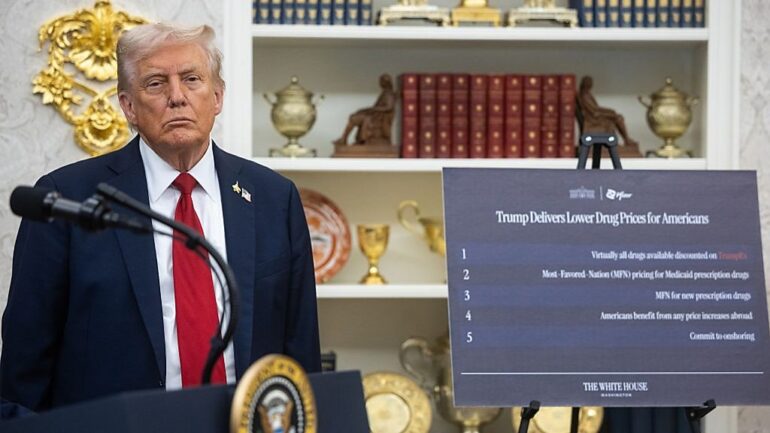On September 30, 2025, President Donald Trump announced a groundbreaking deal with Pfizer, one of the largest U.S. pharmaceutical companies, to reduce prescription drug prices for American consumers. The agreement includes the launch of a new government-operated website called TrumpRx, set to debut in early 2026, where Americans can purchase medications directly from manufacturers at significantly discounted rates. This move is part of Trump’s broader effort to address the high cost of prescription drugs in the United States, which are nearly three times higher than in other developed countries, according to a Health and Human Services Department report from last year.
The Pfizer Deal: Key Details
Under the agreement, Pfizer will offer many of its primary care and specialty brand-name drugs on the TrumpRx website at an average discount of 50% off their list prices. For example, medications like Duavee for post-menopausal osteoporosis will be discounted by 85%, Eucrisa for dermatitis by 80%, Zavzpret for migraines by 50%, and Xeljanz for rheumatoid arthritis by 40%. Additionally, Pfizer has committed to providing “Most Favored Nation” pricing for the Medicaid program, matching the lowest prices offered in other wealthy countries like Canada, France, and Germany. This pricing strategy is expected to reduce costs for Medicaid, the public health insurance program for low-income Americans, starting in early 2026.
Pfizer also pledged to invest $70 billion in U.S. manufacturing, research, and development, a move that aligns with Trump’s push to boost domestic production. In return, the company will avoid tariffs on branded drug imports for three years, providing financial stability. Pfizer’s CEO, Albert Bourla, stated, “We now have the certainty and stability we need on two critical fronts, tariffs and pricing.” Following the announcement, Pfizer’s shares rose nearly 7%.
How TrumpRx Works
The TrumpRx website, expected to launch in early 2026, will allow consumers to search for medications and be redirected to manufacturers’ direct-to-consumer channels to make purchases. Unlike traditional pharmacy purchases, TrumpRx will not involve insurance companies or middlemen like pharmacy benefit managers, which often influence drug costs. The discounts will be based on a drug’s list price, before other rebates or discounts are applied. However, industry experts like Stacie Dusetzina, a professor at Vanderbilt University Medical Center, caution that these discounts may primarily benefit those paying out of pocket, as insured patients might still find lower prices through their insurance plans.
Trump’s Push for Lower Drug Prices
The Pfizer deal follows Trump’s July 2025 letters to 17 pharmaceutical companies, demanding they lower drug prices within 60 days or face consequences, such as a 100% tariff on branded drug imports starting October 1, 2025. Pfizer was the first company to fully comply with Trump’s demands, which included offering “Most Favored Nation” pricing for Medicaid and new drugs, as well as participating in the TrumpRx initiative. Trump indicated that more deals with other drugmakers are expected soon, stating, “This is something that most people said was not doable.”
Trump has long criticized the U.S. for “subsidizing” healthcare costs in other countries, where drug prices are lower due to government-regulated pricing. His “Most Favored Nation” policy aims to align U.S. prices with the lowest net prices in peer countries, after accounting for discounts and rebates. However, Trump acknowledged that his policies might lead to higher drug prices abroad, as companies like Eli Lilly have already announced price increases in Europe to offset lower U.S. prices.
Challenges and Criticisms
While the TrumpRx initiative and Pfizer deal have generated excitement, experts have raised concerns about their effectiveness. Ameet Sarpatwari, an assistant professor at Harvard Medical School, described the deal as “more window dressing” than a transformative solution, noting that the specific terms of Pfizer’s pricing changes remain confidential. Additionally, many of the discounted drugs, like Xeljanz, may soon face generic competition, which could naturally lower prices. The American Journal of Managed Care also reported that the TrumpRx plan could face legal challenges, similar to a blocked “Most Favored Nation” effort during Trump’s first term.
Critics argue that the initiative may not significantly benefit insured Americans, as insurance plans and pharmacy benefit managers play a large role in determining out-of-pocket costs. For example, even with a 40% discount, a drug like Xeljanz could still cost around $3,600 per month, which may be unaffordable for many. NPR reported that an anonymous government official emphasized that TrumpRx discounts apply only to those paying cash, potentially limiting the program’s reach.
What’s Next?
The Trump administration is moving forward with plans to expand the TrumpRx initiative, with additional drugmakers reportedly negotiating similar deals. However, the program’s success hinges on its implementation and ability to navigate legal and logistical hurdles. Analysts warn that without addressing the broader drug pricing system, including the roles of insurers and middlemen, the impact on American consumers may be limited. For now, the Pfizer deal marks a significant step in Trump’s campaign to lower drug costs, but its true impact will become clearer when TrumpRx launches in 2026.
